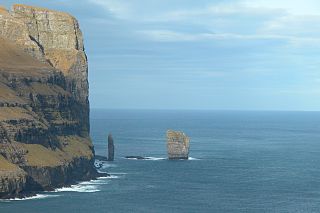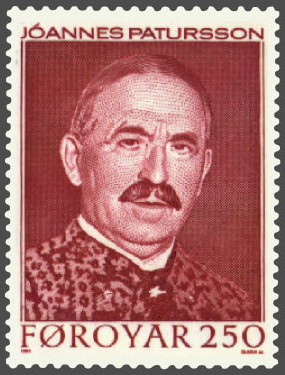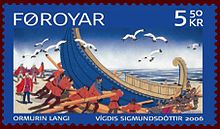
Olaf Tryggvason was King of Norway from 995 to 1000. He was the son of Tryggvi Olafsson, king of Viken, and, according to later sagas, the great-grandson of Harald Fairhair, first King of Norway. He is numbered as Olaf I.

The Battle of Svolder was a large naval battle during the Viking age, fought in September 999 or 1000 in the western Baltic Sea between King Olaf of Norway and an alliance of the Kings of Denmark and Sweden and Olaf's enemies in Norway. The backdrop of the battle was the unification of Norway into a single independent state after longstanding Danish efforts to control the country, combined with the spread of Christianity in Scandinavia.

Venceslaus Ulricus Hammershaimb was a Faroese Lutheran minister who established the modern orthography of Faroese – the language of the Faroe Islands – based on the Icelandic language, which like Faroese, derives from Old Norse.

The culture of the Faroe Islands has its roots in the Nordic culture. The Faroe Islands were long isolated from the main cultural phases and movements that swept across parts of Europe. This means that they have maintained a great part of their traditional culture. The language spoken is Faroese. It is one of three insular North Germanic languages descended from the Old Norse language spoken in Scandinavia in the Viking Age, the others being Icelandic and the extinct Norn, which is thought to have been mutually intelligible with Faroese.
Erik Hakonsson, also known as Eric of Hlathir or Eric of Norway, was Earl of Lade, Governor of Norway and Earl of Northumbria. He was the son of Earl Hákon Sigurðarson and brother of the legendary Aud Haakonsdottir of Lade. He participated in the Battle of Hjörungavágr, the Battle of Svolder and the conquest of England by King Canute the Great.

Ormrinn Langi in Old Norse was one of the most famous of the Viking longships. It was built for the Norwegian King Olaf Tryggvason, and was the largest and most powerful longship of its day. In the late 990s King Olaf was on a "Crusade" around the country to bring Christianity to Norway. When he was traveling north to Hålogaland, he ended up in battle with forces of Raud the Strong, who refused to convert to Christianity. Olaf eventually captured Raud, and gave him two choices: die or convert. The Sagas say that Olaf tried to convert him but Raud cursed the name of Jesus, and the King became so enraged that he, using either the hollow stalk of an angelica or his horn and a red-hot iron, forced a snake down his throat, which ate its way out of the side of the torso of Raud and killed him. After the victory Olaf confiscated Raud's riches, not least of which was Raud's ship, which he rechristened Ormen. He took it to Trondheim and used it as a design for his own new ship, which he made a couple of "rooms" longer than Ormen and named Ormen Lange.

Faroese literature, in the traditional sense of the word, has only really developed in the past two hundred years. This is mainly because of the islands' isolation, and also because the Faroese language was not written down in a standardised format until 1890. Until then the Danish language was encouraged at the expense of Faroese. Nevertheless, the Faroese language soon became a vehicle for literature in its own right and has produced writers in several genres.

Kvæði are the old ballads of the Faroe Islands, accompanied by the Faroese chain dance. They typically recite stories and can have hundreds of stanzas plus a chorus sung between every verse.
Þórðr Sjáreksson was an 11th-century Icelandic skald. He composed a drápa on Þórólfr Skólmsson, four strophes of which have been preserved in the kings' sagas. He also composed a memorial drápa on the canonised Olaf II of Norway, called Róðadrápa, one strophe of which is preserved. A few disjoint strophes by Þórðr on different subjects are also preserved in Skáldskaparmál. Skáldatal reckons Þórðr among the court poets of both Óláfr Haraldsson and Eiríkr Hákonarson.
Skúli Þórsteinsson was an 11th-century Icelandic poet and warrior. He was the grandson of Egill Skallagrímsson and a courtier of Jarl Eiríkr Hákonarson. A short account of his life is given at the end of Egils saga:

Risin og Kellingin are two sea stacks just off the northern coast of the island of Eysturoy in the Faroe Islands close to the town of Eiði. The name Risin og Kellingin means The Giant and the Witch and relates to an old legend about their origins. The Giant (Risin) is the 71m stack further from the coast, and the witch (Kellingin) is the 68m pointed stack nearer land, standing with her legs apart.

The Faroese chain dance is the national circle dance of the Faroe Islands, accompanied by kvæði, the Faroese ballads.
Jens Christian Djurhuus or Sjóvarbóndin was the first poet who wrote in Faroese. He composed several Faroese ballads in traditional style on historical themes. The best known is Ormurin langi. Djurhuus also composed satirical poems directed against Danish rule in the Faroe Islands.

Vigdis Sigmundsdóttir was an artist from the Faroe Islands, known internationally for producing a collage of 12 motives from Ormurin Langi that resulted in a series of stamps from Postverk Føroya released in 2006.

Kollafjørður is a village in the Faroe Islands, located on the island of Streymoy. As of 1. January 2024, the village had a population of 813. Its postal code is FO 410. Until 2001 it was a municipality in its own right but is now part of the Tórshavn Municipality. It is located 21.8 kilometres (13.5 mi) by road north of Tórshavn, and stretches 7 km (4.3 mi) along the fjord of the same name.

Jóannes Patursson was a Faroese nationalist leader and poet. He served as a member of the Parliament of Denmark and the Parliament of the Faroe Islands.

Jens Hendrik Oliver Djurhuus, called Janus Djurhuus, was the first modern Faroese poet. He and his younger brother Hans Andreas Djurhuus, also a poet, are called the Áarstova brothers after the house where they grew up.

Hans Andrias Djurhuus was a Faroese poet and teacher. Hans Andrias Djurhuus was one of the most productive Faroese poets. He is well known for his national poems and for his children's songs, but he also wrote psalms, short stories, plays, fairytales and one novel.

Marianne Clausen was a Danish musicologist and choir conductor. She was the daughter of composer, choir conductor and musicologist Karl Clausen (1904–1972). Her main achievement, begun in collaboration with her father in the early 1970s, intensified during the 1990s, and concluded just weeks before her death, was the preservation of traditional Faroese folk singing, which she presented in a number of large volumes with music notation transcriptions of sound recordings. Based on more than 6,000 such recordings, collected by many different scholars, including herself, throughout the entire 20th century, she published around 3,350 music notation examples of various genres of traditional Faroese singing, together with hitherto unpublished song texts, as well as historical and musicological analyses.
















